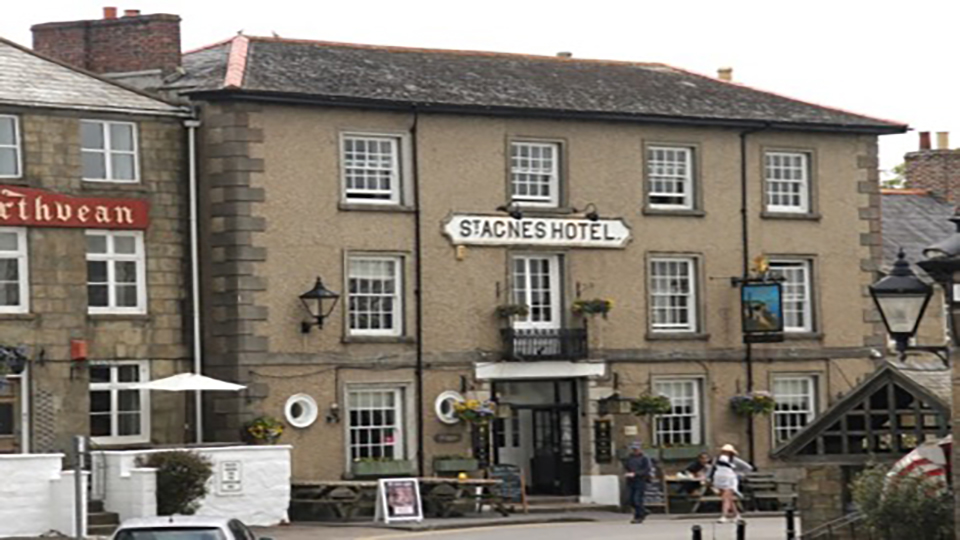
Continuing the series covering the history of Cornish hostelries and ale houses, Tony Mansell presents an interesting history of the public houses and taverns of St Agnes Parish.
St Agnes Parish once had more than its fair share of taverns: many were set up to serve the vibrant mining community who toiled underground, scraping precious minerals from the bowels of the earth. Mostly, these men walked to the mine before making the long descent for their day’s work. At the end of the core they climbed wearily back to grass (surface) to begin the walk home. Who, more than the weary miner, deserved a jar or two in his local alehouse? For some, though, it went further and there are numerous stories of lives ruined and family life destroyed by the demon drink.
For others, hopefully the majority, it was a haven from the daily grind of the workplace and as St Agnes resident Eddie Tredinnick wrote for the 12th Journal of the St Agnes Museum Trust, “Almost every man visited the public house as it was the one place from which the news was circulated and where they could congregate in some degree of comfort to talk.” He added, “Although beer was the common drink, spirits were fairly cheap as they were obtained principally by smuggling! The parish was noted for this and the coastguards and preventative men were busily employed in patrolling and sometimes coming into conflict with those who persisted in carrying out what they regarded as legitimate traffic. The liquor was landed in kegs, often in Perran Bay or under Cligga Head, where it was secured to mules’ backs, one keg on each side, and transported quietly to hiding places.”
From An account of all inns, taverns and ale-houses in the kingdom we know that in 1577 the ale taverns of St Agnes were held by Pawle Polpera, John Rodger, Roger Jeffrye and Robert Nicholas. Later, much later, Eddie Tredinnick wrote, “There were plenty of public houses, beer houses or kiddlywinks(1) in the parish – no less than 40.”
St Agnes is a large parish: it stretches from Porthtowan to Trevellas on the coastline and out to the ‘Chiverton Arms’ on the B3277; it then follows the line of the old A30 through Blackwater and on to Scorrier. Many of the pub names are known to us but there are undoubtedly others which have reverted to dwellings – their history lost.
Blackwater was a mining village. Its thirsty miners had a choice of taverns including the ‘Red Lion’, which is still dispensing drinks, the ‘Spread Eagle’, which stood on the route of the Chacewater to Newquay railway and is now buried under its embankment, and the ‘Cornish Miners Inn’ which was, almost certainly, once occupied and run by William Edwards, the father of the Cornish Philanthropist, John Passmore Edwards.(2)
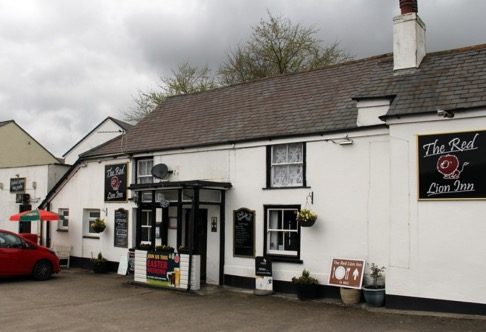
Not far away, a couple of kilometres to the west, is the little hamlet of Wheal Rose with its ‘Plume of Feathers’. It once had a ‘Crown Inn’, a ‘King’s Arms’ and a ‘Cornish Arms’, sadly we are not sure of their exact locations. The Royal Cornwall Gazette of the 5th October 1833 shows the importance of the mining industry here as it advertised the auction of an inn in Wheal Rose.
“To be SOLD by AUCTION on Monday the 14th Oct all that old established INN situate at
WHEAL ROSE in the parish of St Agnes consisting of 8 spacious rooms: brew house, stable and all other necessary outhouses, together with a very rich meadow of land & gardens.
The said INN is situated in the centre of a prosperous mining neighbourhood and is contiguous to the Great Bassett Mine now put to work anew.
For viewing the said premises application to be made to the
Proprietor Mr John James, Goonearl Cottage, St Agnes.”
The village of Mithian is to the right of the road from St Agnes to Perranporth. It once boasted a ‘George III’, a ‘Golden Lion’, a ‘King’s Arms’, a ‘Red Lion’ and a ‘Unicorn’ although with one or two of those we have certainly strayed across the river and into the parish of Perranzabuloe. Only the Miners Arms survives but it is one of the more interesting houses in the parish with its tales of tunnels, smuggling and ghosts. For a mining parish this name is to be expected and H L Douch in Old Cornish Inns wrote, “There were five Miners Arms or Miners Inns in St Agnes. These are often shown without an apostrophe leaving us to wonder whether it should be included before or after the s”.
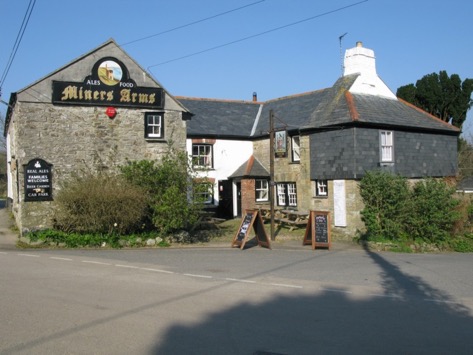
The Miners Arms certainly has its tunnel but for what purpose it was originally constructed we cannot be sure. A Priest hole, maybe, during times of religious persecution but there has also been a definite connection with the “Fair Trade”,(3) sufficient to make us believe that its use in the mid-1800s was not restricted to hiding recalcitrant priests. William Mitchell, landlord during the early 1840s, was a member of a local fish seine(4) which was allegedly a front for a smuggling syndicate.
It does not require too much imagination to link a pub with a tunnel and a smuggling landlord. A little later, in the late 1800s, it was the subject of a closing order when it was described as a house of ill repute. It had apparently become a base for some ladies-of-the-night. A building as old as the Miners Arms is certain to have its ghost stories and it doesn’t disappoint. The appearance of ghostly figures, glasses falling off shelves yet remaining unbroken and sachets of sauces strewn all over the room are the stuff of supernatural tales.
There is a famous song The Pub with no Beer, for many years Mount Hawke was the village with no pub. To explain why, we turn to a 1920 un-named booklet where it said, “The cause of Temperance has always found a number of staunch supporters in Mount Hawke and it is probably owing to their implacable antipathy to the drink that the village rejoices in the fact that it is without a public house.” The movement was not without its detractors, however, and when a prominent temperance lecturer was due to speak in the chapel it seemed as though it would split the village. The Methodist Minister heard of it and confronted the organiser. “I understand that you have announced a Temperance address for next week in the chapel.”
“I have,” replied the Brother.
“It must not take place. I forbid the use of the chapel for such a purpose. I shall lock the door.”
The Brother was not to be dissuaded and replied, “The meeting will take place and if you lock the door I shall burst it open.”
At that time the Wesleyans were undecided in their attitude towards the movement and matters came to a head when the chapel authorities refused to admit the Rechabite banners. Historian Ashley Rowe referred to the “Teetotal Village” in the West Briton when he said that the movement came to Mount Hawke in the 1850s. Miners returning from America, the old forty-niners, had joined the Rechabites(5) and wished to have a lodge in their home village.
Mr Rowe wrote, “The ‘Red Lion Inn’, closed its doors and although some beer-shops or kiddley-winks held out for a while, they too had to disappear.”
The West Briton of the 6th November 1863 reported the story.
“The last representative of John Barleycorn(6) also practised the cobbling art but by some means or other, mine host found that leathering the sole and running the spirit was an unprofitable calling. From the best authorities upon the matter we learn that the evil eye of ruin was upon the house and the unlucky cobbler escaped from the malevolence of the monster by striking his colours in the night and hoisting ‘Mr… shoemaker’ the next morning…”
Eventually the thirsty inhabitants found the journey to the ‘The Victory’ at Towan Cross a bit tiring and in 1963 the ‘Pent-Y-Bryn’ opened its doors. The ‘Old School’ followed in the 1980s but for many years Mount Hawke (3 km south of St Agnes) was, indeed, the village with no pub.
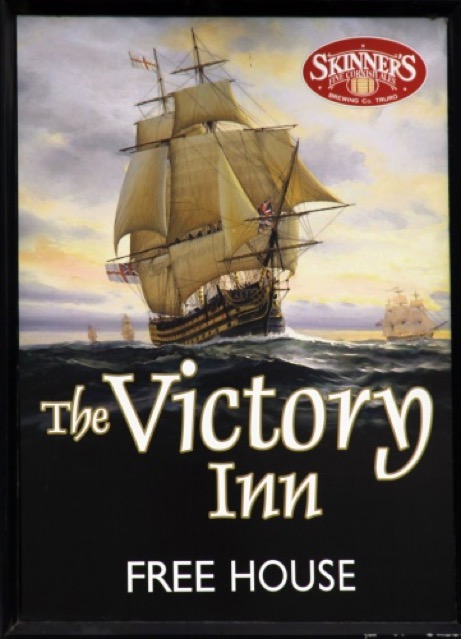
Porthtowan is on the western fringe of the parish and is a favourite beach resort for both locals and visitors. The ‘Unicorn’ (previously ‘Commodore’) is now the largest public house in the village but there were many other establishments including the ‘Egypt’ which, according to Eddie Tredinnick, was where water was collected for use at the local tea-treat.(7) Whether this was a public house or an area of the village we are not certain.
The largest village in the parish is St Agnes where the many public houses served a 19th century population similar in size to that of today. That was, of course, prior to the Cornish diaspora when thousands of cousins Jacks and cousin Jennys left these shores to find work in other parts of the world. St Agnes Churchtown had the ‘Cornish Arms’ (or ‘15 Balls’), ‘Golden Lion’, ‘Plume of Feathers’, ‘Ship Inn’, ‘White Hart’, ‘White Lion’ and the ‘St Agnes Hotel’ (previously the ‘King’s Arms Inn’, ‘Pearce’s Hotel’, ‘Commercial Hotel’ and ‘Paul’s Hotel’). This last house dates from the 18th Century and is the only one remaining open in Churchtown.
The Sherborne Mercury of December 1775 advertised,
“To be let and entered upon at Christmas next all that commodious old accustomed inn known by the sign of King’s Arms, St Agnes with all the appurtances (sic) thereto belonging, consisting of a very good stable, an outer kitchen, brew house, a very large yard and about one acre and a quarter of very rich land …”. Its thatched roof was replaced with slate in 1825 and for many years it included a tailor’s shop but that has now been incorporated into the bar area. Gone, too, is the division between the public bar and the lounge and occasionally the mind flips back to the old layout with the serving hatch for those who preferred to use the wide hall and to the cold winter’s nights with rum and black treacle bubbling away on the fire.
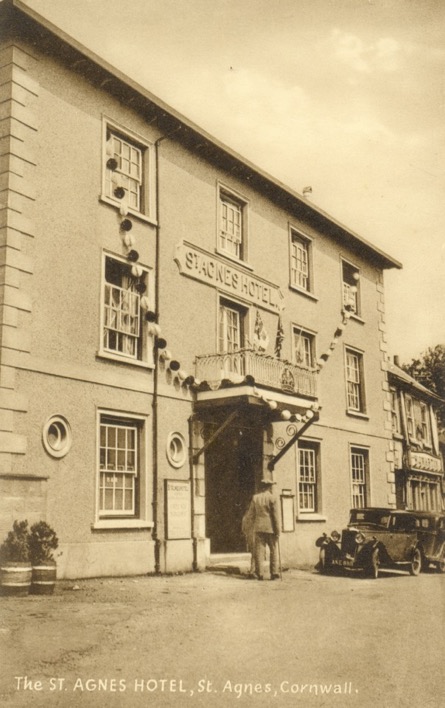
The St Agnes Hotel is the home of the St Agnes Golf Society (STAGS) where the members have met since its inception in 1971. It is also the venue for two very Cornish annual events: the St Agnes Hotel Christmas Euchre (playing card) Competition (since 1986) and the St Agnes Men’s Pasty-making World Championships where individual entries have been known to sell for in excess of £400.
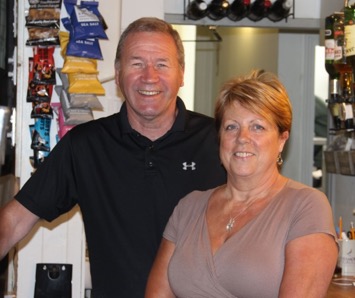
A little further up the street, in an area once known as Vicarage, was the ‘Carpenter’s Arms’, ‘George IV’ and the ‘Railway Inn’ (previously ‘Smiths Arms’ and ‘Smiths and Railway Arms’) which is still open. The first landlord of the ‘Railway’, during the 1840s, was Thomas Tregellas, a blacksmith who had his workshop on the opposite side of the road. At that time the smuggling of liquor was prevalent and, according to local historian Frank Carpenter, Thomas was the most noteworthy. When he died he was buried in the graveyard opposite where, it was said, he could keep an eye on his pub.
Mickey Dunne was a legendary landlord at the ‘Railway’. Sometime during the 1940s Mickey and Rita Dunne arrived in St Agnes to view the establishment but his first impression was not good. They were still considering it when they were told that the train back to Truro was due into St Agnes Station. They arrived to find the guard waving the green flag and blowing his whistle. The train had already begun to pull out of the station but in a moment the guard changed the flag to red and the driver reversed. As they boarded, Mickey shouted to the Devenish Manager, “I’ll take the pub: if St Agnes can stop the train for me then I am for St Agnes”. Following that there was a virtual name change as the house was most often referred to as ‘Mickey Dunne’s’.
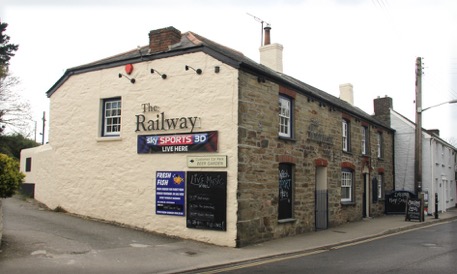
St Agnes Peterville, previously known as Dirtypool, has had a number of drinking establishments. During the 1890s ‘The Victoria’ was owned by Chummy Reynolds. He brewed his own beer and kept the pub open at all hours, even at 5.00 am when miners were changing shifts. The ‘Peterville Inn’ dates from the early 1800s and Clive Benney, in Down to Dirty Pool wrote that it was once the rendezvous for old timers at a period when, as they put it, “beer was beer and you could stand your spoon up in it”. Some of these old boys were in the bar for most of the day and night drinking a gallon or even two. There was so much revelling over the weekend that absenteeism from the mines on Monday morning was such a regular feature that the day became known as Maze Monday.
St Agnes Quay has had at least three public houses across the years. The ‘Golden Lion’ (previously ‘Red Lion’) where it is said that it was not unusual for miners to come off core at Wheal Kitty Mine, walk down the side of the coombe to the pub where they would drink until they fell into a drunken sleep. When they awoke it was time to start work again and they would climb back up the side of the valley to the mine without having been to their homes.
The ‘Ship and Castle’ dates from the early 1830s and Frank Carpenter suggested that it was a thriving establishment with constant trade from vehicles delivering and collecting from ships at anchor, harbour workers, crews of vessels in the harbour and tinners from the mines. The ‘Driftwood Spars’ is more recent. It opened in 1952 and is still serving its customers. The building, however, is steeped in history and is shown on the 1841 tithe map as a warehouse and fish cellar.
This, of course, is not the end of the story. Public houses come and go while others evolve in line with customer demands but they have always, and hopefully always will, provided an indispensable community amenity.
Footnotes
(1) Kiddlywink (sometimes spelt kiddleywink) is an old name for a Cornish beer shop or beer house. They were licensed to sell beer or cider by the Customs & Excise rather than by a Magistrate’s Licence which was required by traditional Taverns and Inns. They were reputed to be the haunts of smugglers and often had an unmarked bottle of spirits under the counter.
(2) John Passmore Edwards (24 March 1823 – 22 April 1911) was a British journalist, newspaper owner and philanthropist. He was born in Blackwater, a small village between Redruth and Truro in Cornwall. A lifelong champion of the working classes, Passmore Edwards is remembered as a generous benefactor. Over the space of 14 years, 70 major buildings were established as a direct result of his bequests. These included hospitals, libraries, schools, convalescence homes and art galleries. He was also a generous donor to the Workers’ Educational Association.
(3) Fair Trade is a colloquial term used for smuggling.
(4) Seine fishing (or seine-haul fishing) is a method of fishing that employs a seine or dragnet. A seine is a fishing net that hangs vertically in the water with its bottom edge held down by weights and its top edge buoyed by floats.
(5) The Rechabites – variously the Order of Rechabites, the Sons and Daughters of Rechab, and so on were founded on August 25, 1835 in Salford, near Manchester, England, as a fraternal benefit total-abstinence society. In Cornwall, well into the second half of the 20th century, a common description of extreme intoxication was “as drunk as a Rechabite on the annual outing”. Such is the irreverent Cornish sense of humour; for the Rechabites are a strict Temperance movement.
(6) John Barly Corn is an anecdotal reference to the demon drink derived from songs penned by numerous composers.
(7) Tea treats. See BBC Article Naomi Kennedy; Cornish Methodist “teatreats” seemed unique. During the late 19th century and for several decades after, villages in Cornwall were served by various chapels. Each chapel had a Sunday School and the village children were expected to attend. The annual Whit Monday “tea treat” (a date in late May to coincide with the festival of Whitsun) was the highlight of the season. http://www.bbc.co.uk/cornwall/content/articles/2009/05/04/teatreat_history_feature.shtml
You can find the third in the series on the public houses and taverns of Truro here.
